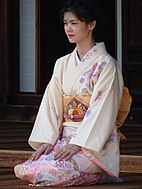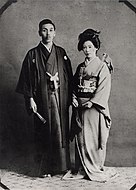
Back Kimono Afrikaans كيمونو Arabic Kimono Azerbaijani Kimono BCL Кімано Byelorussian Кимоно Bulgarian কিমোনো Bengali/Bangla Quimono Catalan Kimono Czech Kimono Danish


| Kimono | |||||
|---|---|---|---|---|---|
'Kimono' in kanji | |||||
| Japanese name | |||||
| Kanji | 着物 | ||||
| |||||
The kimono (きもの/着物, lit. 'thing to wear')[a] is a traditional Japanese garment and the national dress of Japan. The kimono is a wrapped-front garment with square sleeves and a rectangular body, and is worn left side wrapped over right, unless the wearer is deceased.[2] The kimono is traditionally worn with a broad sash, called an obi, and is commonly worn with accessories such as zōri sandals and tabi socks.
Kimono have a set method of construction and are typically made from a long, narrow bolt of cloth known as a tanmono, though Western-style fabric bolts are also sometimes used.[3] There are different types of kimono for men, women, and children, varying based on the occasion, the season, the wearer's age, and – less commonly in the modern day – the wearer's marital status. Despite the kimono's reputation as a formal and difficult-to-wear garment, there are types of kimono suitable for both formal and informal occasions. The way a person wears their kimono is known as kitsuke (着付け, lit. 'dressing').
The history of the kimono can be tracked back to the Heian period (794–1185), when Japan's nobility embraced a distinctive style of clothing. Formerly the most common Japanese garment, the kimono has fallen out of favor and is rarely worn as everyday dress now. They are most often seen at summer festivals, where people frequently wear the yukata, the most informal type of kimono. More formal types are worn to funerals, weddings, graduations, and other formal events. Geisha and maiko are required to wear a kimono as part of their profession, and rikishi (sumo wrestlers) must wear kimonos at all times in public.[4] Despite the small number of people who wear it regularly and its reputation as a complicated garment, the kimono has experienced a number of revivals in previous decades, and is still worn today as fashionable clothing in Japan.
- ^ Dalby, Liza (1993). Kimono: Fashioning Culture (1st ed.). Seattle: University of Washington Press. ISBN 9780099428992.
- ^ Spacey, John. "5 Embarrassing Kimono Mistakes". japan-talk.com. Japan Talk. Retrieved 27 January 2020.
- ^ "About the size of tanmono (a roll of kimono cloth)". hirotatsumugi.jp. Hirota Tsumugi. Archived from the original on 4 July 2020. Retrieved 27 January 2020.
- ^ Sharnoff, Lora (1993). Grand Sumo: The Living Sport and Tradition. Weatherhill. ISBN 0-8348-0283-X.
Cite error: There are <ref group=lower-alpha> tags or {{efn}} templates on this page, but the references will not show without a {{reflist|group=lower-alpha}} template or {{notelist}} template (see the help page).
© MMXXIII Rich X Search. We shall prevail. All rights reserved. Rich X Search


